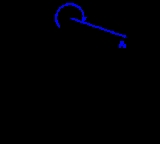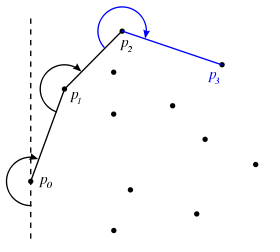
Gift wrapping algorithm
Encyclopedia
In computational geometry
, the gift wrapping algorithm is an algorithm
for computing the convex hull
of a given set of points.
(nh) time complexity
, where n is the number of points and h is the number of points on the convex hull. Its real-life performance compared with other convex hull algorithms is favorable when n is small or h is expected to be very small with respect to n. In general cases the algorithm is outperformed by many others.
 For the sake of simplicity, the description below assumes that the points are in general position
For the sake of simplicity, the description below assumes that the points are in general position
, i.e., no three points are collinear. The algorithm may be easily modified to deal with collinearity, including the choice whether it should report only extreme point
s (vertices of the convex hull) or all points that lie on the convex hull. Also, the complete implementation must deal with degenerate cases when the convex hull has only 1 or 2 vertices, as well as with the issues of limited arithmetic precision, both of computer computations and input data.
The gift wrapping algorithm begins with i=0 and a point p0 known to be on the convex hull, e.g., the leftmost point, and selects the point pi+1 such that all points are to the right of the line pi pi+1. This point may be found in O(n) time by comparing polar angles of all points with respect to point pi taken for the center of polar coordinates. Letting i=i+1, and repeating with until one reaches ph=p0 again yields the convex hull in h steps. In two dimensions, the gift wrapping algorithm is similar to the process of winding a string (or wrapping paper) around the set of points.
The approach can be extended to higher dimensions.
pointOnHull = leftmost point in S
i = 0
repeat
P[i] = pointOnHull
endpoint = S[0] // initial endpoint for a candidate edge on the hull
for j from 1 to |S|-1
if (endpoint pointOnHull) or (S[j] is on left of line from P[i] to endpoint)
P[0] // wrapped around to first hull point
.
However, because the running time depends linearly on the number of hull vertices, it is only faster than O(n log n) algorithms such as Graham scan
when the number h of hull vertices is smaller than log n. Chan's algorithm
, another convex hull algorithm, combines the logarithmic dependence of Graham scan with the output sensitivity of the gift wrapping algorithm, achieving an asymptotic running time O(n log h) that improves on both Graham scan and gift wrapping.
Computational geometry
Computational geometry is a branch of computer science devoted to the study of algorithms which can be stated in terms of geometry. Some purely geometrical problems arise out of the study of computational geometric algorithms, and such problems are also considered to be part of computational...
, the gift wrapping algorithm is an algorithm
Algorithm
In mathematics and computer science, an algorithm is an effective method expressed as a finite list of well-defined instructions for calculating a function. Algorithms are used for calculation, data processing, and automated reasoning...
for computing the convex hull
Convex hull
In mathematics, the convex hull or convex envelope for a set of points X in a real vector space V is the minimal convex set containing X....
of a given set of points.
Planar case
In the two-dimensional case the algorithm is also known as Jarvis march, after R. A. Jarvis, who published it in 1973; it has OBig O notation
In mathematics, big O notation is used to describe the limiting behavior of a function when the argument tends towards a particular value or infinity, usually in terms of simpler functions. It is a member of a larger family of notations that is called Landau notation, Bachmann-Landau notation, or...
(nh) time complexity
Time complexity
In computer science, the time complexity of an algorithm quantifies the amount of time taken by an algorithm to run as a function of the size of the input to the problem. The time complexity of an algorithm is commonly expressed using big O notation, which suppresses multiplicative constants and...
, where n is the number of points and h is the number of points on the convex hull. Its real-life performance compared with other convex hull algorithms is favorable when n is small or h is expected to be very small with respect to n. In general cases the algorithm is outperformed by many others.
Algorithm

General position
In algebraic geometry, general position is a notion of genericity for a set of points, or other geometric objects. It means the general case situation, as opposed to some more special or coincidental cases that are possible...
, i.e., no three points are collinear. The algorithm may be easily modified to deal with collinearity, including the choice whether it should report only extreme point
Extreme point
In mathematics, an extreme point of a convex set S in a real vector space is a point in S which does not lie in any open line segment joining two points of S...
s (vertices of the convex hull) or all points that lie on the convex hull. Also, the complete implementation must deal with degenerate cases when the convex hull has only 1 or 2 vertices, as well as with the issues of limited arithmetic precision, both of computer computations and input data.
The gift wrapping algorithm begins with i=0 and a point p0 known to be on the convex hull, e.g., the leftmost point, and selects the point pi+1 such that all points are to the right of the line pi pi+1. This point may be found in O(n) time by comparing polar angles of all points with respect to point pi taken for the center of polar coordinates. Letting i=i+1, and repeating with until one reaches ph=p0 again yields the convex hull in h steps. In two dimensions, the gift wrapping algorithm is similar to the process of winding a string (or wrapping paper) around the set of points.
The approach can be extended to higher dimensions.
Pseudocode
jarvis(S)pointOnHull = leftmost point in S
i = 0
repeat
P[i] = pointOnHull
endpoint = S[0] // initial endpoint for a candidate edge on the hull
for j from 1 to |S|-1
if (endpoint
pointOnHull) or (S[j] is on left of line from P[i] to endpoint)
endpoint = S[j] // found greater left turn, update endpoint
i = i+1
pointOnHull = endpoint
until endpoint
P[0] // wrapped around to first hull pointComplexity
The inner loop checks every point in the set S, and the outer loop repeats for each point on the hull. Hence the total run time is O(nh). The run time depends on the size of the output, so Jarvis March is an output-sensitive algorithmOutput-sensitive algorithm
In computer science, an output-sensitive algorithm is an algorithm whose running time depends not only on the size of the input but also on the size of the output...
.
However, because the running time depends linearly on the number of hull vertices, it is only faster than O(n log n) algorithms such as Graham scan
Graham scan
The Graham scan is a method of computing the convex hull of a finite set of points in the plane with time complexity O. It is named after Ronald Graham, who published the original algorithm in 1972...
when the number h of hull vertices is smaller than log n. Chan's algorithm
Chan's algorithm
In computational geometry, Chan's algorithm, named after Timothy M. Chan, is an optimal output-sensitive algorithm to compute the convex hull of a set P of n points, in 2 or 3 dimensional space. The algorithm takes O time, where h is the number of vertices of the output...
, another convex hull algorithm, combines the logarithmic dependence of Graham scan with the output sensitivity of the gift wrapping algorithm, achieving an asymptotic running time O(n log h) that improves on both Graham scan and gift wrapping.

